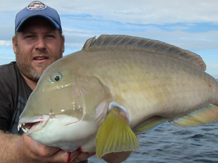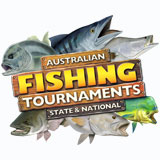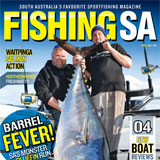Species ID
View AllBaldchin Groper

Baldchin Groper are an inshore demersal tuskfish and a member of the wrasse family. They display many of the same features as other wrasse species such as large slimy scales and a broad powerful tail. Baldchin range in colour from greeny-brown to orange in smaller specimens to greeny-blue with yellow and/or orange fins in larger specimens. They are a beautiful looking fish and are distinguished by a white patch at the base of the pectoral fins and a large white patch on their chin from the opening of the mouth to the base of the gills. The teeth of baldchin appear to be tusk-like and are well adapted for catching and crushing their prey. They are quite thick through the body and are a powerful opponent to recreational anglers.
Other names
Baldchin, Baldies, Bluebone, Baldchin Tuskfish, Baldchin Wrasse, Tuskfish, Westralian Baldchin Groper
Common size
1-4kg
Related species
Black-spotted Tuskfish, Venus Tuskfish, Blue Groper
Lifespan
Up to 25 years
Habitat
Baldies are a demersal (bottom-dwelling) reef fish which inhabit inshore and offshore coral and weedy reefs. Larger specimens are more often found at depth while juveniles prefer shallower weedy habitats.
Reproduction
Baldchin are sequential hermaphrodites which display protogyny, meaning they change sex from female to male during their life-cycle. This ‘sex-change’ occurs after about 8-12 years and 48-55cm in size. Baldchin grow to about 90cm and 9kg. Baldies spawn between late spring to mid-summer.
Diet
Baldies feed on invertebrates within the reef system including urchins, crustaceans and shellfish.
Pound for pound
Baldies are a tough fighter and pound-for-pound are one of WA’s best fighting reef fish. Off the rocks they can have you on your knees and busted up in a matter of seconds, while in the boat they go just as hard.
Catch care
If you decide to keep a baldy dispatch of it humanely and immediately after capture, otherwise release carefully with aid of a release weight. Store your catch on ice in an esky/ice box or for better results mix up a good ice slurry with saltwater. Kept like this your fish will last much longer and will still be fresh when you get home from a long day on the water.
Information courtesy of Department of Fisheries, WA
Baldchin Groper are endemic to Australian waters where their distribution is limited to Western Australia from Coral Bay southwards to Cape Naturaliste in the south. Baldchin are found in waters along coastal cliffs and rock platforms to as far wide as the continental shelf in a common depth range between only a few meters to 40m, and up to 100m. They are found in great numbers at the Abrolhos Islands offshore from Geraldton where a network of shallow reefs with their plentiful food supply appears to be the perfect habitat for this species to thrive.
5 stars. Baldies are arguably the best eating of all wrasses and are one of Australia’s top eating demersal fish. The beautiful thick, firm and white flesh is a favourite of many WA anglers and for that reason, along with their fighting ability, they are definitely one of WA’s most sought after and prized catches. Because their flesh is so tasty try not to disguise it too much. Skinned, boneless fillets are delicious simply baked or shallow fried dusted in a light flour and seasoning. However, baldy is so versatile and tasty in most dishes from curries to barbecued it will be fantastic no matter how you cook it!

- Can grow up to 90cm in length
- Baldchin Groper are a member of the family Labridae (wrasses), the 2nd largest family or marine fishes
- They are found nowhere else in the world outside of WA
- All baldchin are born female and change sex to male at 8-12 years of age
- They are highly susceptible to barotrauma (equivalent to ‘the bends’) when caught
- They are slow-growing and vulnerable to overfishing
- Have been known to spawn in congregations of up to 100 individuals
- Good eating





























